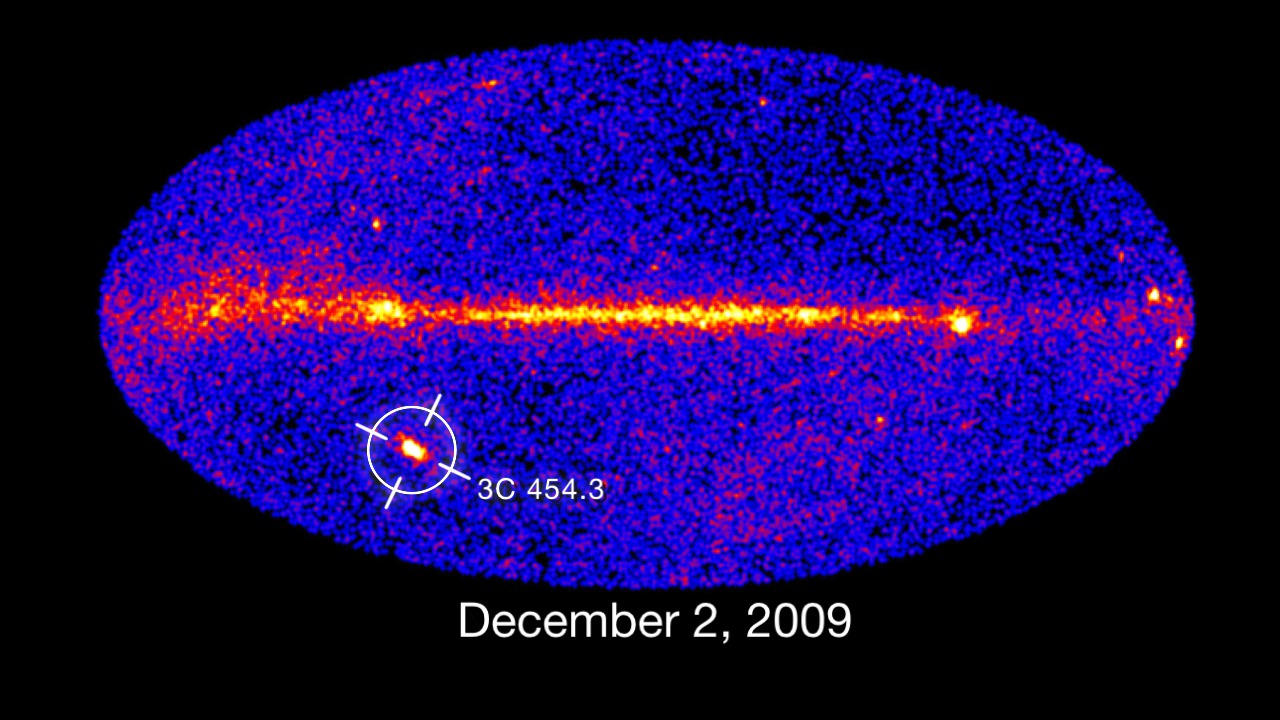First Gamma-ray Measurement of a Gravitational Lens
Astronomers using NASA's Fermi observatory have made the first gamma-ray measurements of a gravitational lens, a kind of natural telescope formed when a rare cosmic alignment allows the gravity of a massive object to bend and amplify light from a more distant source.
The opportunity arose in September 2012, when Fermi's Large Area Telescope (LAT) detected a series of bright gamma-ray flares from a source known as B0218+357, located 4.35 billion light-years away in the constellation Triangulum. These powerful outbursts in a known gravitational lens provided the key to making the measurement.
Astronomers classify B0218+357 as a blazar, a type of active galaxy noted for intense outbursts. At the blazar's heart is a supersized black hole with a mass millions to billions of times that of the sun. As matter spirals toward this black hole, some of it blasts outward as jets of particles traveling near the speed of light in opposite directions.
Long before light from B0218+357 reaches us, it passes directly through a spiral galaxy – one much like our own – located 4.03 billion light-years away. The galaxy's gravity bends the light into different paths, so astronomers see the background blazar as dual images. But these paths aren't the same length, which means that when one image flares, there's a delay of many days before the other does.
While radio and optical telescopes can resolve and monitor the individual blazar images, Fermi's LAT cannot. Instead, the Fermi team exploited the playback delay between the images.
In September 2012, when the blazar's flaring activity made it the brightest gamma-ray source outside of our own galaxy, Fermi scientists took advantage of the opportunity by using a week of dedicated LAT time to hunt for delayed flares.
Three episodes of flares showing playback delays of 11.46 days were found, with the strongest evidence in a sequence of flares captured during the week-long LAT observations.
This movie illustrates the components of a gravitational lens system known as B0218+357. Different sight lines to a background blazar result in two images that show outbursts at slightly different times. NASA's Fermi made the first gamma-ray measurements of this delay in a lens system.
Credit: NASA's Goddard Space Flight Center

This Hubble image of the gravitational lens B0218+357 reveals two bright sources separated by about a third of an arcsecond, each an image of the background blazar. Faint spiral arms belonging to the lensing galaxy also can be seen. B0218+357 boasts the smallest separation of lensed images currently known. The A image (4 o'clock position) is where changes are first observed and is significantly fainter than the B image (center) at optical wavelengths.
Credit: NASA/ESA and the Hubble Legacy Archive

Print resolution still of gravitational lens system illustration.
Credit: NASA's Goddard Space Flight Center

Print resolution still of gravitational lens system illustration. No labels.
Credit: NASA's Goddard Space Flight Center

Print resolution still of gravitational lens system illustration. No labels or light paths.
Credit: NASA's Goddard Space Flight Center
For More Information
Credits
Please give credit for this item to:
NASA's Goddard Space Flight Center. However, individual images should be credited as indicated above.
-
Animator
- Scott Wiessinger (USRA)
-
Producer
- Scott Wiessinger (USRA)
-
Writer
- Francis Reddy (Syneren Technologies)
Release date
This page was originally published on Monday, January 6, 2014.
This page was last updated on Wednesday, May 3, 2023 at 1:51 PM EDT.
